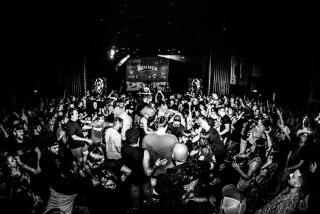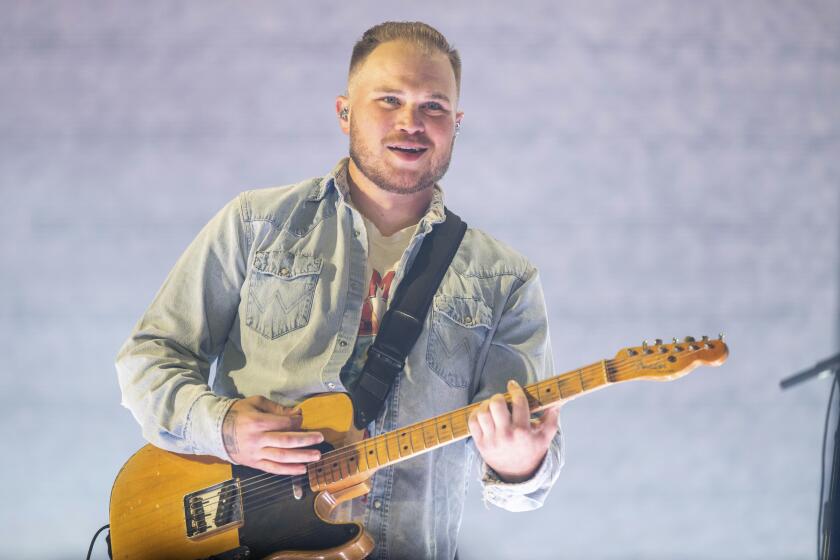Music, not tech, powers South by Southwest party
AUSTIN, Texas — During Vancouver rock duo Japandroids’ gig on Wednesday night at the South by Southwest music festival, singer-guitarist Brian King made a midset, cuss-laden declaration about their performance: “When we [mess] up, it’s not a mistake — it’s a live remix.”
The distinction was a clever take on clashing worlds at the year’s biggest musical gathering, which runs through Sunday. The primal grunt of the guitar and the bang of the drum were the only instruments Japandroids needed to state their case — especially during a searing version of the Gun Club’s “For the Love of Ivy.”
But half a block away at Elysium, the dance music website Resident Advisor was showcasing the inner musical soul of the computer through textured synthetic rhythms and noise that culminated with a powerful set of minimal electronic dub by British producer Andy Stott.
PHOTOS: The scene at SXSW 2013
The first few days of the event have seen artists such as electronic soul singer Sohn harnessing digital technology to transform his voice while crowds bounced along on analog legs. More voluminous and insistent, though, have been all the young punks and rockers like Brooklyn’s DIIV, whose love of fingers on strings suggest little interest in pushing any button more advanced than an on/off switch.
If remix music suggests the encroaching future, the kids playing punk in Austin are reacting by throwing dirt into the motherboards, and reinventing old-school aggression as a new brand of folk music. Too, rappers like L.A.’s Earl Sweatshirt and Action Bronson have brought a rebel urgency to next-generation hip-hop lyricism, proving once again that a single voice can make a deep impression with little more than a beat and a brain.
The result is a music festival that has the sound and feel of a world in remix flux. The sense of unfinished, open-sourced chaos is everywhere, from the new ways to create music to new means to finance and distribute it. In the 15 years I’ve been attending, the push-pull between art and commerce, music’s cutting-edge sounds and tried and true formulas, between youthful indiscretion and aged patience, has never seemed more pronounced. Nor has the center been as absent.
Country singers vie with techno producers, rappers, rock stars, has-beens, buskers and gearheads. Corporations and major labels book superstars such as Kid Cudi, Green Day and (rumor has it) Justin Timberlake to perform big rap, rock and pop in undersized clubs but also sponsor punk showcases with bands like Black Breath and Hatred Surge.
STORY: SXSW 2013: A night of discoveries as the headliners arrive
The result is SXSW as a petri dish of tech, cash and melody, offering further fuel to the argument that the most important change in music in this decade is not any single artistic voice or stylistic movement — but in the way that sounds are
produced, disseminated and experienced — and the artistic consequences of this shift.
On an experiential level, the festival has never been better, thanks to technology. Gone are the days spent flipping through a printed schedule and jotting notes in the margins; with the new SXSW smartphone application (sponsored by Showtime) a portal to the thousands of events is instantly accessible and easily personalized. A tweet from a tastemaker can turn a nobody into a could-be in mere seconds. Not sure if you’re down with Ohio metal band Skeletonwitch? Stand outside the club Mohawk, open your Spotify app and stream a listen.
This giant shift in access is, in part, what Spotify founder Daniel Ek argued on Tuesday as prompting “a new age of renaissance in creativity.” “Twenty years ago, you had to learn how to play an instrument really well to learn how to play music,” Ek said, adding that “the tools to actually create music have become so cheap that anyone can do it, but that doesn’t mean anyone ‘can’ do it. The value of the true creative geniuses will increase.”
Maybe. On cynical days my philosophy can be summed up as, “There are too many people in the world, and too many of them make music,” and evidence of mediocrity and mimicry abounds in Texas. The problem of how to separate the dull from the rare genius will never be solved by a gadget; the only way to tell if a band is any good is to see it live.
During Iggy Pop and the Stooges’ inspired bit of rock primalism, for example, my attention was torn between experiencing the moment and conveying the experience of the moment, the brain and eyes at war, working to think up witticisms to tweet while ears were occupied on the proto-punk band’s jumbo version of “Raw Power.” While Pop was running around shirtless, my thumb muscles, eyeballs and ear drums were juggling tasks and getting workouts. Then I focused on bassist Mike Watt chugging on his instrument, a whole other kind of portal opened and I was, thank God, once again lost in music.
My first few days, in fact, have been a constant battle between ear and eye attention, wondering what’s going on not only down Red River but also on social networks and via text. Yes, I’ve added my own video data into the stream, and my followers saw through an electronic window, nearly in real time, something going on half a world away.
My most jarring and explosive moments thus far have been mostly analog, coming from bands too busy kicking rock ass to check their Instagrams. Scottish power trio Paws tore through the club Red 7 during a Stones Throw/Forcefield PR afternoon set on Wednesday, killing the crowd with nothing but guitar, bass and drum. New Zealand-American group Unknown Mortal Orchestra made beautiful, soulful guitar rock that sounded both familiar and innovative.
An English guitarist named Jake Bugg, just signed to a major, looked like he was about 15 but had a big, dynamic voice and crammed a truckload of melodic information into a mere eight-bar Fender run.
And in a memorable late-night introduction at Scoot Inn, L.A. beat producer Flying Lotus announced the arrival onto the South by Southwest stage of a prodigious young rapper. Lotus, who has been working on tracks with the rapper, stepped up to a microphone and said simply, “Introducing Earl Sweatshirt,” and there was the skinny 18-year-old Odd Future member whose rise as a rapper consumes acres of the Internet.
Over the next half-hour, Earl proved why not only rap fans but advocates of the English language should be so excited.
The best new song he offered, produced by Pharrell Williams of the Neptunes, was called “Burgundy” and featured Earl rapping raw about the fear that has accompanied his whirlwind few years.
“My priorities are [messed] up, I know it/ I’m afraid I’m gonna blow it/ And the expectations raising ‘cause daddy was a poet,” he rapped, giving voice to the age-old story of prodigious youth and oversized expectations, a theme that never vanishes from a gathering like this one.
PHOTOS AND MORE
COACHELLA: Complete 2013 lineup
THE ENVELOPE: Awards Insider
PHOTOS: Grammy top winners
More to Read
The biggest entertainment stories
Get our big stories about Hollywood, film, television, music, arts, culture and more right in your inbox as soon as they publish.
You may occasionally receive promotional content from the Los Angeles Times.









